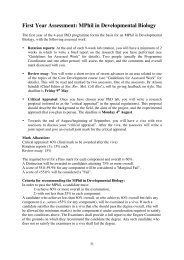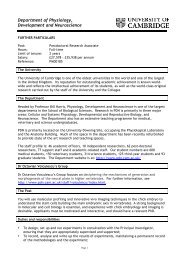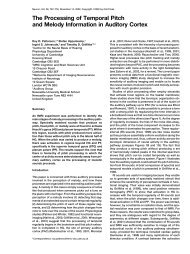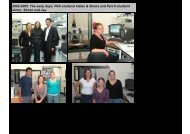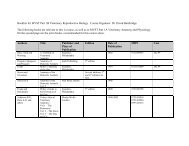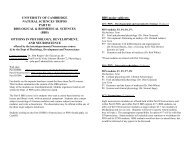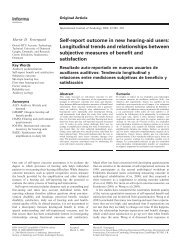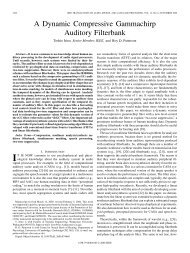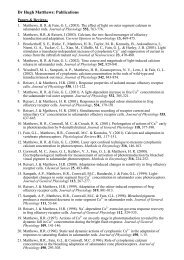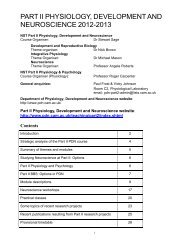FRIDAY MORNING, 20 MAY 2005 REGENCY E, 8:30 A.M. TO 12:00 ...
FRIDAY MORNING, 20 MAY 2005 REGENCY E, 8:30 A.M. TO 12:00 ...
FRIDAY MORNING, 20 MAY 2005 REGENCY E, 8:30 A.M. TO 12:00 ...
You also want an ePaper? Increase the reach of your titles
YUMPU automatically turns print PDFs into web optimized ePapers that Google loves.
11:15<br />
5aNS8. Digital identification of intrusive noise: Pilot study to digitally characterize soundscapes and intrusion. Tim Lavallee<br />
LPES, Inc., 14053 Lawnes Creek Rd., Smithfield, VA 234<strong>30</strong>, Robert Kull Parsons, Norfolk, VA 23502, and Brigitte<br />
Schulte-Fortkamp ITA/TU-Berlin, Einsteinufer 25, D-10587 Berlin, Germany<br />
One of the difficulties with soundscape investigation and the definition of intrusion is the need for an individual to manually<br />
identify and log specific acoustical events. Event logging can be labor intensive, costly, and difficult to standardize. If information<br />
about physical setting and in situ acoustical signatures can be used to define a given soundscape, event logging could possibly be<br />
performed digitally and intrusion could be defined based on the spectral fingerprint of a given soundscape. Two soundscapes with<br />
different settings and acoustical signatures were identified. Sound time histories and periodic third octave spectra were measured over<br />
a given period. An individual manually logged acoustical events. Independently, algorithms to identify both normal and acoustically<br />
intrusive events for the given soundscape were applied to the data. The digitally identified events were compared to the manually<br />
taken event log. An evaluation of the results will be presented.<br />
11:35<br />
5aNS9. Evaluation of sound environment characteristics: Comparative study between objective and subjective criteria.<br />
Francoise Chartier and Catherine Semidor GRECO, EAPBx, Domaine de Raba F-334<strong>00</strong> Talence, France,<br />
catherine.semidor@bordeaux.archi.fr<br />
The evaluation of urban sound environment quality depends on quantitative information as well as the opinion of city dwellers. In<br />
order to underline the relation between objective and subjective points of view, a comparative study was carried out. The subjective<br />
survey consisted in listening to several binaural sound recordings of very short extracts from the urban scene, called ‘‘sonoscene.’’<br />
During these sessions, the listeners’ opinions were noted. The binaural sound recordings are performed in accordance with the<br />
‘‘soundwalk’’ method explained in previous papers C. Semidor, ASA <strong>20</strong>04, ASA <strong>20</strong>05. The same binaural sound recordings were<br />
analyzed in form of objective criteria such as Equivalent Sound Level, Loudness, Roughness, etc. This paper deals with the comparison<br />
between some of these objective criteria and subjective judgments such as Lack or Presence of traffic noise, Lack or Presence<br />
of human activities, Spatial Dimension, Attractiveness or Annoyance, etc. These first results point out some significant correlations<br />
between Loudness and Attractiveness for example, according to the nature of the sound sources traffic, human activity.<br />
<strong>FRIDAY</strong> <strong>MORNING</strong>, <strong>20</strong> <strong>MAY</strong> <strong>20</strong>05<br />
<strong>REGENCY</strong> B, 8:<strong>00</strong> <strong>TO</strong> 10:<strong>00</strong> A.M.<br />
Session 5aPAa<br />
Physical Acoustics: Topics in Acoustic Mine Detection<br />
Murray S. Korman, Chair<br />
Physics Dept., U.S. Naval Academy, Annapolis, MD 21402<br />
Contributed Papers<br />
8:<strong>00</strong><br />
5aPAa1. Long-range excitation of vibrational response in landmines<br />
with Rayleigh and Love waves. Thomas Muir Natl. Ctr. for Physical<br />
Acoust., Univ. Mississippi, One Coliseum Dr., University, MS 38677<br />
An experiment was conducted in a clay soil at a range of 25 m from<br />
two types of electromagnetic shaker sources, operating in a cw pulse mode<br />
centered at 1<strong>00</strong> Hz. The sources were in co-located arrays, one vertically<br />
oriented to generate Rayleigh waves and another transversely oriented to<br />
generate Love waves. Two cylindrical landmine targets were used: an<br />
unloaded empty plastic shell, and a metal shell, loaded with paraffin to<br />
simulate an explosive. These target types represent extreme variations in<br />
what could conceivably be encountered. The targets were instrumented<br />
with three-axis seismometers and accelerometers, and were also viewed<br />
with a laser Doppler vibrometer LDV. Data were acquired on both mine<br />
cases in various stages of deployment, including sitting upon the ground<br />
surface, snugged in to a tight hole in the ground, and completely buried<br />
some 5 cm beneath the surface. The responses of the mine cases to Rayleigh<br />
and Love wave excitation were measured and compared to data from<br />
a reference seismometer deployed nearby, on natural, undisturbed soil.<br />
The mine case responses to these seismic excitation fields, under a number<br />
of conditions are presented and discussed. Work supported by the U.S.<br />
Marine Corps Systems Command.<br />
8:15<br />
5aPAa2. Influence of buried objects on the dynamic nonlinearity of<br />
inhomogeneous materials. Keith Attenborough, Qin Qin Dept. of<br />
Eng., Univ. of Hull, Hull HU6 7RX, UK, Jonathan Jefferis, and Gary<br />
Heald DSTL, Fort Halstead, Kent, UK<br />
Donskoy et al. J. Acoust. Soc. Am. 111, 2705–2714 <strong>20</strong>02 and Korman<br />
et al. J. Acoust. Soc. Am. 116, 3354–3369 <strong>20</strong>04 have shown that<br />
the nearby presence of compliant buried objects results in a significant<br />
nonlinear response in the spectrum of surface vibration induced by acoustic<br />
excitation. The latter have suggested that there is a strong connection<br />
with the inherent Nonlinear Mesoscopic Elasticity NME of inhomogeneous<br />
materials. Laboratory experiments are reported that investigate the<br />
comparative NME of granular and fibrous materials and the variation observed<br />
between several states of a single material sand subject to high<br />
sound pressure levels in the frequency range 1<strong>00</strong> Hz to 2 kHz. Fiberglass<br />
and gravel are shown to have strong inherent nonlinearity whereas wet<br />
compacted sand has relatively little. In both two-tone and single tone<br />
experiments, it is shown that, the presence of buried objects may enhance<br />
or reduce the inherent NME of the embedding medium. In cases where the<br />
NME is enhanced, compliant buried objects have a greater effect than<br />
relatively stiff objects. Work supported by DSTL, UK.<br />
5a FRI. AM<br />
2593 J. Acoust. Soc. Am., Vol. 117, No. 4, Pt. 2, April <strong>20</strong>05 149th Meeting: Acoustical Society of America 2593



